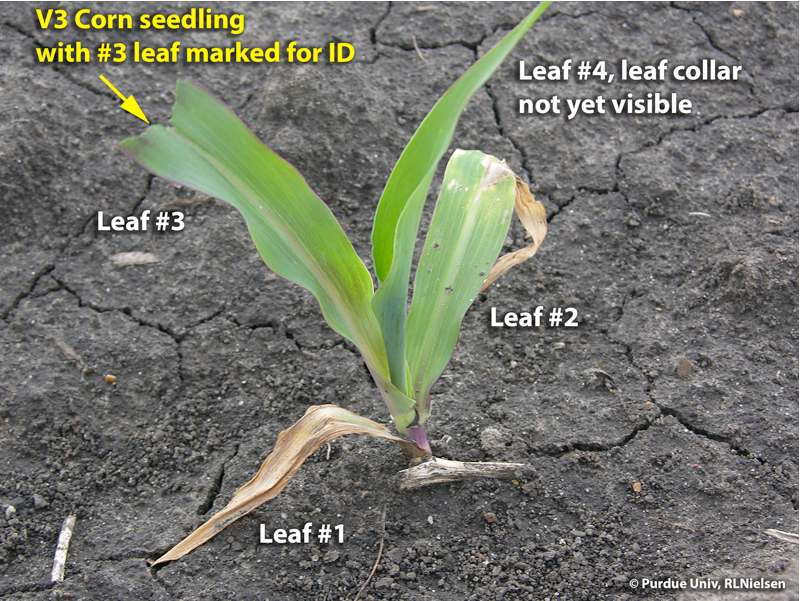It is not uncommon for young corn plants to suffer severe leaf damage from frost, freezing temperatures, or hail. Such weather-related events usually lead to vigorous debate over coffee and rolls down at the local cafe as to how one goes about staging corn that survives the defoliation caused by such events.
Some may wonder why this topic is worthy of discussion. The reason lies with the fact that a number of post-emergence corn herbicides can only be applied to corn up to a label-specified leaf stage (Ikely and Johnson, 2018). Growers and applicators obviously need to be able to accurately stage corn plants, even if damaged, to determine whether application of a such herbicides will still be within label restrictions.
Unfortunately, dead leaf tissue does not resurrect itself and will eventually slough off as the plants continue to grow. A common question I hear from farmers is whether the leaf stage of a recovered plant begins anew with the healthy leaves expanding from the whorl or whether the dead leaves (which may no longer be identifiable) should be counted. In other words, should a 5-leaf plant that has lost four leaves to frost injury now be considered a 1-leaf plant?
The simple answer is: A V5 plant is a V5 plant no matter how many lower leaves are damaged, dead, or otherwise missing. As long as the dead lower leaves remain attached to the plants, leaf staging is reasonably simple. Count the dead leaves and any additional ones with visible leaf collars (Nielsen, 2019a).
The challenge occurs when the dead lower leaves slough off and decompose or blow away. Now how do you count leaves if you are not sure whether the lowermost remaining leaf is #2 or #3? This is not a problem when staging V7 or older corn because one can then split stalks to identify the 5th node and its respective attached leaf, then count the remaining leaves with collars above that leaf (Nielsen, 2019a).
However, this technique does not work well for corn plants younger than about V6 or V7 because stalk elongation up to about that stage is not far enough along for you to use the “split stalk” technique. Unfortunately, a number of post-emergence herbicides have label restrictions for applications to corn older than V5 or V6 (Ikely and Johnson, 2018) and so there is a need to be able to accurately estimate the leaf stage of corn plants that were damaged at earlier leaf stages.
Here are two alternatives for staging damaged young corn:
1) Walk damaged and recovering fields as soon as you can while the dead lower leaves of damaged plants are still attached. Mark ten consecutive plants with plot flags or garden stakes. Identify and record the leaf number of the lowermost healthy leaf (one likely to remain attached for some time) of each plant. Mark each such leaf by simply ripping off a third or half of the leaf blade. To simplify future leaf staging, similarly mark the same leaf number on each of the 10 consecutive plants. When you come back in a week or later to stage the plants again, find the marked leaf on each plant and continue counting the number of leaves with visible leaf collars.
2) Predict leaf stage development based on thermal time (growing degree days or GDDs) from planting or emergence (Nielsen, 2019b). The relationship between corn development and temperature is reasonably strong. Emergence occurs about 115 to 120 GDDs from planting and leaf collar emergence (up to about leaf #10) requires about 82 GDDs per leaf. The online Corn GDD Tool (https://hprcc.unl.edu/gdd.php) is a good source of actual and estimated GDD accumulations for specific locations you choose.
Related References
Andresen, Jeff, Jim Angel, Larry Biehl, Roger Elmore, Beth Hall, Chad Hart, Tom Hultquist, Ray Massey, Chris Panza, Brian Raub, Martha Shulski, Dennis Todey, Melissa Widhalm, and Ray Wolf. 2019. U2U Decision Support Tools – Corn GDD. High Plains Regional Climate Center. https://hprcc.unl.edu/gdd.php [URL accessed May 2019]
Ikley, Joe and Bill Johnson. 2018. Growth Stage Cutoffs for Herbicide Applications in Corn and Soybean. Pest & Crop Newsletter, Purdue Univ. Extension. https://extension.entm.purdue.edu/newsletters/pestandcrop/article/growth-stage-cutoffs-for-herbicide-applications-in-corn-and-soybean [URL accessed May 2019].
Nielsen, R.L. (Bob). 2017. Heat Unit Concepts Related to Corn Development. Corny News Network, Purdue Univ. Extension http://www.kingcorn.org/news/timeless/HeatUnits.html. [URL accessed May 2019].
Nielsen, R.L. (Bob). 2019a. Determining Corn Leaf Stages. Corny News Network, Purdue Univ. Extension http://www.kingcorn.org/news/timeless/VStageMethods.html [URL accessedMay 2019].
Nielsen, R.L. (Bob). 2019b. Use Thermal Time to Predict Leaf Stage Development in Corn. Corny News Network, Purdue Univ. Extension http://www.kingcorn.org/news/timeless/VStagePrediction.html. [URL accessed 5/8/08].






